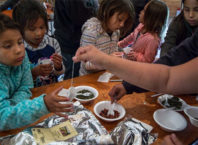The Northwest Portland Area Indian Health Board’s (NPAIHB) suicide prevention project called THRIVE has recently created an AI/AN specific suicide prevention media campaign and with the support of the Indian Health Service. It wanted to expand the campaign nationally to include youth bullying preventionRe by partnering with a few Tribal communities.
Red Lake Nation with its unique status was one of the first to come to mind, and the group contacted Red Lake Executive Administrator Lea Perkins who then contacted local Red Lake artist Sarah Lussier.
The idea was to create a work of art in a visible place, by selecting a wall, building or structure to paint a community suicide prevention mural project. The mural would be done by a native artist from each community selected. The mural would be reflective of the community reaching out to individuals to let them know that they have support from the community.
Lussier, aided by high school art teacher and artist in his own right, Patrick Desjarlait, Sr., came up with an upbeat concept called "Spirit of Hope" relating to bullying and suicide prevention. The high school allowed them a wall near the front door near large windows, and a beautiful work of art was created.
Once the mural was painted a model would be photographed as if they were the ones being reached out too. Lussier chose her sister Eliza Lussier, as the model. "She symbolizes the youth within our community", said Lussier who prides herself as a member of the Red Lake Band of Chippewa Indians.
"I’m 30-years-old, a little too old for the campaign for high school students," smiled Lussier. She says that she’s had no formal training in art. "I’ve been into drawing as long as I can remember and during my teenage years, my art progressed to acrylic paintings. I cultivated a deeper passion toward interior decorating; therefore, my primary focus isn’t acrylics anymore although I still enjoy painting."
"I think this mural is a great way to collaborate with the community as an out reach project by addressing suicide and youth bullying", said Lussier. "I was proud to be selected and am pleased that my art work may be displayed on many reservations throughout the country, and more than that hopefully call attention to bullying and suicide prevention."
The photograph of Lussier’s sister (using the mural as background) will become part of a print/poster campaign to be disseminated to all U. S. Reservations. The mural background and others will be used for flyers, posters, websites, etc. The text can be changed to announce events and trainings or other suicide prevention activities. Tribal logos can also be put on each print ad by the respective Tribe.
"Community is the Healer that Breaks the Silence."
The Concept Background
Research has shown that people contemplating or having thoughts of suicide feel alone and that nobody understands them or what they are going through. The thoughts behind the mural campaign are to engage Reservation Communities to get behind the message of supporting those who may have or maybe contemplating suicide. To let them know that their communities are there for them and that the individuals have places and people to talk too.
"There is a strong link between bullying and suicide, as suggested by recent bullying-related suicides in the US and other countries", says Albert Allick of the Indian Health Service.
Bullying is recognized as a major public health problem in the Western world, and it appears to have devastating consequences. Cyberbullying has become an increasing public concern in light of recent cases associated with youth suicides that have been reported in the mass media.
"Most of the studies that have examined the association between bullying and suicidality have been cross-sectional," says Allick. "Those studies show that bullying behavior in youth is associated with depression, suicidal ideation, and suicide attempts. These associations have been found in elementary school, middle school, and high school students. Moreover, victims of bullying consistently exhibit more depressive symptoms than nonvictims; they have high levels of suicidal ideation and are more likely to attempt suicide than non-victims."
"The results pertaining to bullies are less consistent," Allick goes on. "Some studies show an association with depression, while others do not. The prevalence of suicidal ideation is higher in bullies than in persons not involved in bullying behavior. Studies among middle school and high school students show an increased risk of suicidal behavior among bullies and victims. Both perpetrators and victims are at the highest risk for suicidal ideation and behavior."
The Statistics on Bullying and Suicide are Alarming:
Suicide is the third leading cause of death among young people, resulting in about 4,400 deaths per year, according to the CDC. For every suicide among young people, there are at least 100 suicide attempts. Over 14 percent of high school students have considered suicide, and almost 7 percent have attempted it.
Bully victims are between 2 to 9 times more likely to consider suicide than non-victims, according to studies by Yale University. A study in Britain found that at least half of suicides among young people are related to bullying. According to statistics reported by ABC News, nearly 30 percent of students are either bullies or victims of bullying, and 160,000 kids stay home from school every day because of fear of bullying.
Bully-related suicide can be connected to any type of bullying, including physical bullying, emotional bullying, cyberbullying, and sexting, or circulating suggestive or nude photos or messages about a person.
Some of the warning signs of suicide can include:
o Showing signs of depression, like ongoing sadness, withdrawal from others, losing interest in favorite activities, or trouble sleeping or eating.
o Talking about or showing an interest in death or dying.
o Engaging in dangerous or harmful activities, including reckless behavior, substance abuse, or self injury.
o Giving away favorite possessions and saying goodbye to people.
o Saying or expressing that they can’t handle things anymore.
o Making comments that things would be better without them.
If a person is displaying these symptoms, talk to them about your concerns and get them help right away, such as from a counselor, doctor, or at the emergency room.
In some cases, it may not be obvious that a teen is thinking about suicide, such as when the suicide seems to be triggered by a particularly bad episode of bullying. In several cases where bullying victims killed themselves, bullies had told the teen that he or she should kill him or herself or that the world would be better without them. Others who hear these types of statements should be quick to stop them and explain to the victim that the bully is wrong.
Other ways to help people who may be considering suicide include:
o Take all talk or threats of suicide seriously. Don’t tell the person they are wrong or that they have a lot to live for. Instead, get them immediate medical help.
o Keep weapons and medications away from anyone who is at risk for suicide. Get these items out of the house or at least securely locked up.
o Parents should encourage their teens to talk about bullying that takes place. It may be embarrassing for kids to admit they are the victims of bullying, and most kids don’t want to admit they have been involved in bullying. Tell victims that it’s not their fault that they are being bullied and show them love and support. Get them professional help if the bullying is serious.
o It is a good idea for parents to insist on being included in their children’s friends on social networking sites so they can see if someone has posted mean messages about them online. Text messages may be more difficult to know about, so parents should try to keep open communications with their children about bullying.
o Parents who see a serious bullying problem should talk to school authorities about it, and perhaps arrange a meeting with the bully’s parents. More states are implementing laws against bullying, and recent lawsuits against schools and criminal charges against bullies show that there are legal avenues to take to deal with bullies. If school authorities don’t help with an ongoing bullying problem, local police or attorneys may be able to.
o People who are thinking about suicide should talk to someone right away or go to an emergency room. They can also call a free suicide hotline, such as 1-800-273-TALK (8255).
Friends and relatives of suicide victims also need to find someone to talk to as they grieve, especially if they are suffering from depression or suicidal thoughts themselves.
Suicide Exacts a Profound Toll on American Indians
Suicides and suicide-related behaviors exact a profound toll on American Indian and Alaska Native communities. Suicides reverberate through close-knit communities and continue to affect survivors many years after the actual incident.
American Indian teens take their own lives at more than two times the rate of any other teen demographic in the USA, according to statistics from the Centers for Disease Control and Prevention. Of course, these numbers are just averages, so on certain reservations the suicide rate is exponentially higher. But calculating the numbers is easy. It’s the reasons that are harder to fathom.
Most are kids who do not have drugs or alcohol problems. Many come from financially comfortable families, by Native American standards. And most don’t leave a suicide note, so their loved ones suffer the pain of regrets and self blame without the relief of being able to know the true reasons.
Mental Health Considerations:
o When compared with other racial and ethnic groups, American Indian/Alaska Native youth have more serious problems with mental health disorders related to suicide, such as anxiety, substance abuse, and depression.
o Mental health services are not easily accessible to American Indians and Alaska Natives, due to: lack of funding, culturally inappropriate services, and mental health professional shortages and high turnover. For these reasons, Native Americans tend to underutilize mental health services and discontinue therapy.
Ethnic and Cultural Considerations
o According to the U. S. Commission on Civil Rights, Native Americans continue to experience higher rates of poverty, poor educational achievement, substandard housing, and disease.
o Elements of acculturation – mission and boarding schools, weakening parental influence, and dislocation from native lands – undermine tribal unity and have removed many safeguards against suicide that Native American culture might ordinarily provide.
o There are very few evidence-based programs that are adapted for American Indian and Alaska Native cultures.
Strengths and Protective Factors
o The most significant protective factors against suicide attempts among American Indian/Alaska Native youth are: discussion of problems with family or friends, or connectedness to family, and emotional health.
o Culturally sensitive programs that strengthen family ties, including addressing substance abuse, could protect against suicide among Native American adolescents.
o A study of American Indians living on reservations found that tribal spiritual orientation was a strong protective factor. Individuals with a strong tribal spiritual orientation were half as likely to report a suicide attempt in their lifetimes.
Sources:
WebMD, Depression Guide, "Recognizing the Warning Signs of Suicide"
Nemours, KidsHealth, "Helping Kids Deal with Bullies"
Centers for Disease Control and Prevention, Suicide Prevention, "Youth Suicide"
Yale University, Office of Public Affairs, "Bullying-Suicide Link Explored in New Study by Researchers at Yale"
Matt Dickinson, The Independent, "Research finds bullying link to child suicides"
Michael Inbar, MSNBC Today, "Sexting & bullying cited in teens suicide"
Susan Donaldson James, ABC News, Health, "Teen Commits Suicide Due to Bullying: Parents Sue School for Son’s Death"
Erik Eckholm and Katie Zezima, The New York Times, "6 Teenagers Are Charged After Classmate Suicide"






